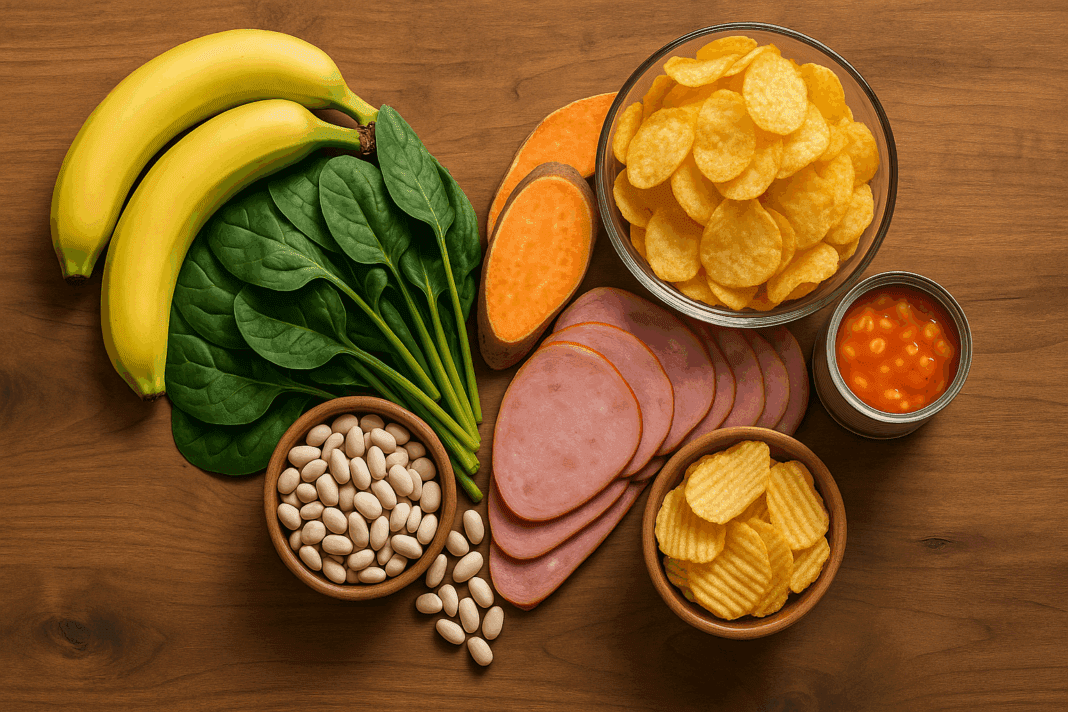The intricate dance between sodium and potassium within the human body is a subject of increasing scientific attention, particularly when it comes to cardiovascular health. These two electrolytes, while chemically distinct, share a deeply interdependent relationship that can significantly influence blood pressure, fluid balance, and overall heart function. As public health campaigns continue to raise awareness about sodium reduction, the question arises: can potassium cancel out sodium? This question is more than just nutritional curiosity; it touches on key mechanisms that govern cardiovascular wellness and may hold the key to more effective dietary strategies for preventing heart disease.
You may also like: Macronutrients vs Micronutrients: What the Simple Definition of Macronutrients Reveals About Your Diet and Health
In the age of processed food and convenience meals, sodium intake has skyrocketed beyond recommended thresholds in many parts of the world. The World Health Organization advises a daily limit of 2,000 mg of sodium, yet the average global consumption often doubles that. Excess sodium increases the volume of fluid in the bloodstream, placing added stress on blood vessels and elevating blood pressure. Potassium, in contrast, acts as a physiological counterbalance. It helps relax blood vessel walls, aids in excreting excess sodium through urine, and contributes to overall electrolyte stability. This interplay between sodium and potassium suggests that a high-potassium diet may mitigate some of the damage caused by high sodium consumption, but the extent to which potassium can “cancel out” sodium is still a matter of scientific nuance.
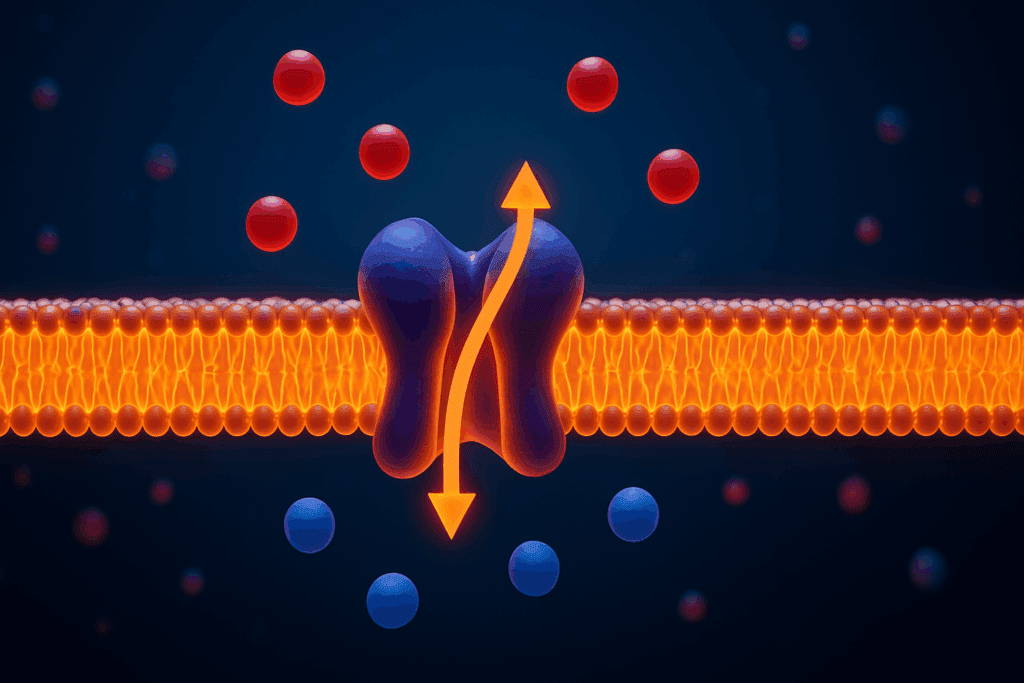
Understanding the Sodium-Potassium Balance in the Body
To appreciate the full implications of the sodium and potassium relationship, it is important to understand how these minerals function at the cellular level. Sodium primarily resides in the extracellular fluid and plays a critical role in nerve impulse transmission, muscle contraction, and fluid balance. Potassium, by contrast, is predominantly found inside cells, where it supports cellular metabolism, enzymatic activity, and the maintenance of electrical gradients.
The sodium-potassium pump, a fundamental mechanism in nearly every cell, actively transports sodium out and potassium into cells, thereby maintaining the necessary electrochemical balance. This pump is essential for the physiological stability of organs like the heart, brain, and kidneys. Disruptions in this balance—either through excessive sodium intake, insufficient potassium consumption, or both—can impair these systems and increase the risk of chronic conditions like hypertension, stroke, and heart disease. Thus, the question of whether potassium can cancel out sodium is not merely about one nutrient negating the effects of another; it’s about how a delicate equilibrium can tip toward either health or disease.

Scientific Evidence Supporting the Role of Potassium in Sodium Regulation
Emerging evidence from clinical studies and large-scale population data supports the hypothesis that higher potassium intake is associated with better cardiovascular outcomes, particularly among those with high sodium diets. A 2011 study published in the Archives of Internal Medicine found that individuals with the highest potassium-to-sodium intake ratio had a significantly lower risk of cardiovascular events and all-cause mortality. This suggests that the balance between these two nutrients may be more important than their individual intakes alone.
Moreover, the DASH (Dietary Approaches to Stop Hypertension) diet, widely endorsed by physicians and health organizations, emphasizes a pattern of low sodium and high potassium foods. It includes fruits, vegetables, legumes, and dairy products—all naturally rich in potassium. Numerous clinical trials have demonstrated that adherence to the DASH diet can lower blood pressure within just a few weeks, especially in hypertensive individuals. This reinforces the concept that a low sodium, high potassium dietary pattern offers synergistic benefits.
Despite these promising findings, researchers caution against assuming that potassium alone can completely counteract high sodium intake. The biological mechanisms at play are complex, and while potassium facilitates sodium excretion and blood vessel relaxation, it cannot fully reverse the vascular damage caused by long-term excessive sodium consumption. Therefore, optimal health outcomes are best achieved not just by increasing potassium but also by actively reducing sodium intake.
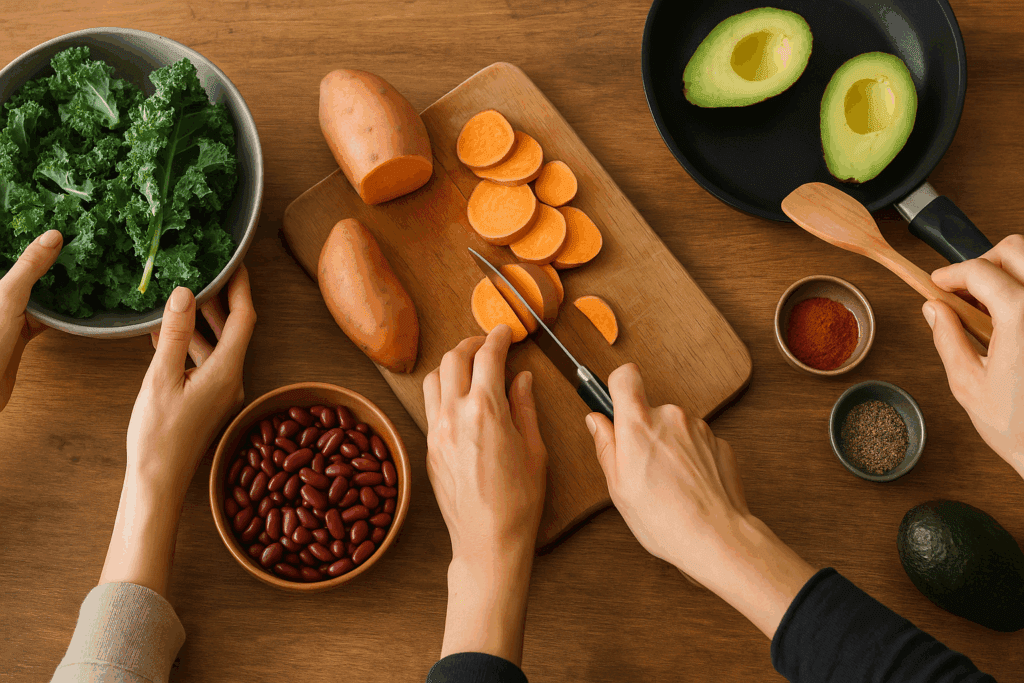
Practical Strategies for Achieving a Low Sodium High Potassium Diet
One of the most effective ways to support heart health through nutrition is by adopting a dietary approach that focuses on both reducing sodium and increasing potassium. This involves more than simply adding a banana to breakfast or swapping table salt for a low-sodium alternative. It requires a comprehensive shift in eating habits and food choices that prioritize whole, unprocessed foods.
Fruits and vegetables are among the richest sources of potassium. Bananas, oranges, spinach, sweet potatoes, and avocados all deliver high levels of this heart-friendly mineral. Legumes like lentils and kidney beans, as well as dairy products such as yogurt and milk, also contribute meaningfully to daily potassium intake. On the flip side, processed and packaged foods are the main culprits behind excessive sodium consumption. Items like canned soups, frozen meals, deli meats, and fast food often contain sodium not just as a flavor enhancer but also as a preservative.
Cooking at home with fresh ingredients, using herbs and spices instead of salt, and reading food labels to monitor sodium content are practical, evidence-based strategies. Potassium-based salt substitutes can also be helpful, especially for individuals trying to transition away from high-sodium diets. However, it is crucial to consult a healthcare provider before making significant dietary changes, particularly for individuals with kidney disease, where potassium levels must be carefully regulated.
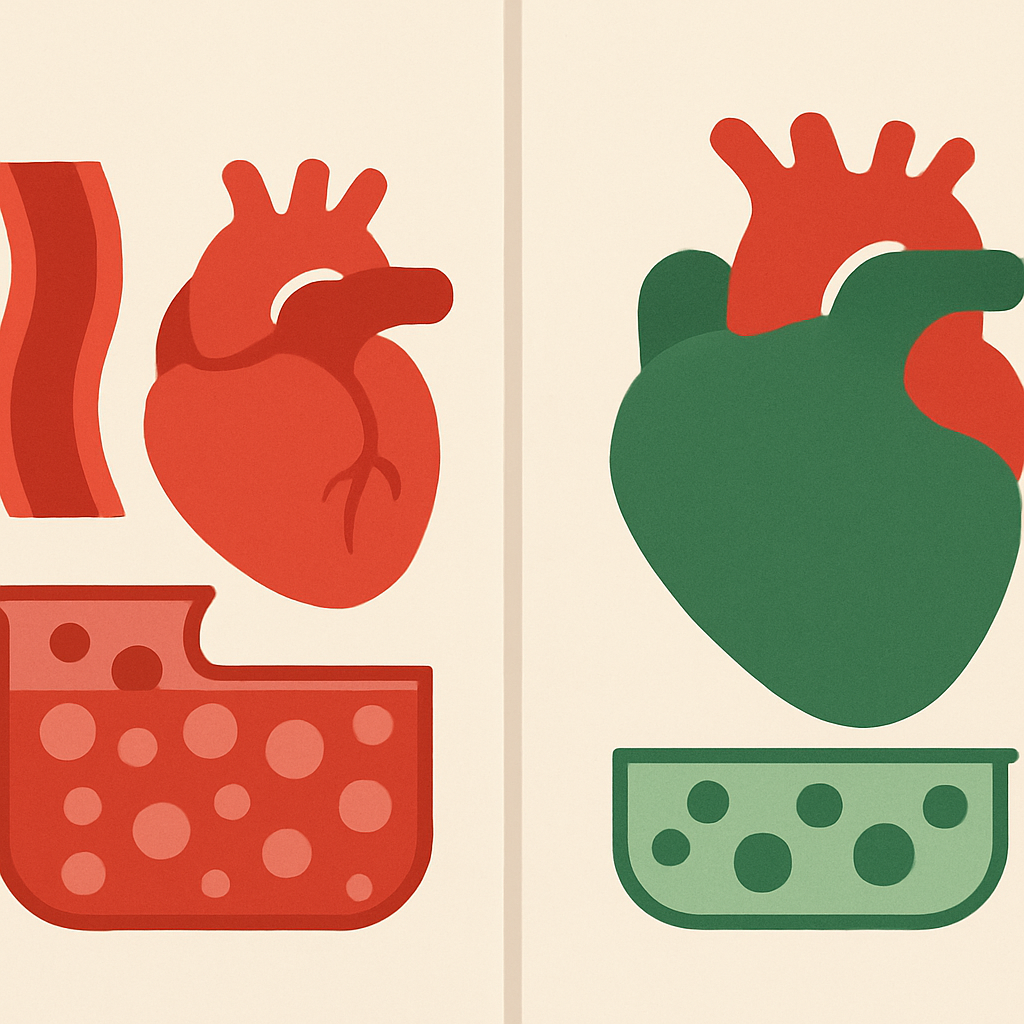
How Sodium and Potassium Interact to Affect Blood Pressure and Heart Function
Blood pressure regulation is one of the most well-documented areas in which the balance between sodium and potassium exerts a significant impact. High sodium intake tends to increase blood volume and vascular resistance, thereby elevating blood pressure. Potassium, conversely, promotes vasodilation and enhances the kidneys’ ability to excrete sodium. This dual action supports lower blood pressure levels and reduces the workload on the heart.
Clinical evidence indicates that individuals who consume a diet high in sodium but also high in potassium tend to have lower blood pressure than those who consume high sodium and low potassium diets. This suggests that while potassium may not entirely cancel out the effects of sodium, it can blunt their intensity, thereby offering partial protection. The net effect depends heavily on the ratio of sodium to potassium in the diet, as well as individual genetic and lifestyle factors.
Interestingly, research also shows that people with certain genetic variants related to sodium sensitivity may benefit even more from a high-potassium diet. In these individuals, the sodium and potassium interplay becomes particularly important, and small dietary adjustments can lead to significant changes in blood pressure regulation. This highlights the growing importance of personalized nutrition in managing cardiovascular risk.
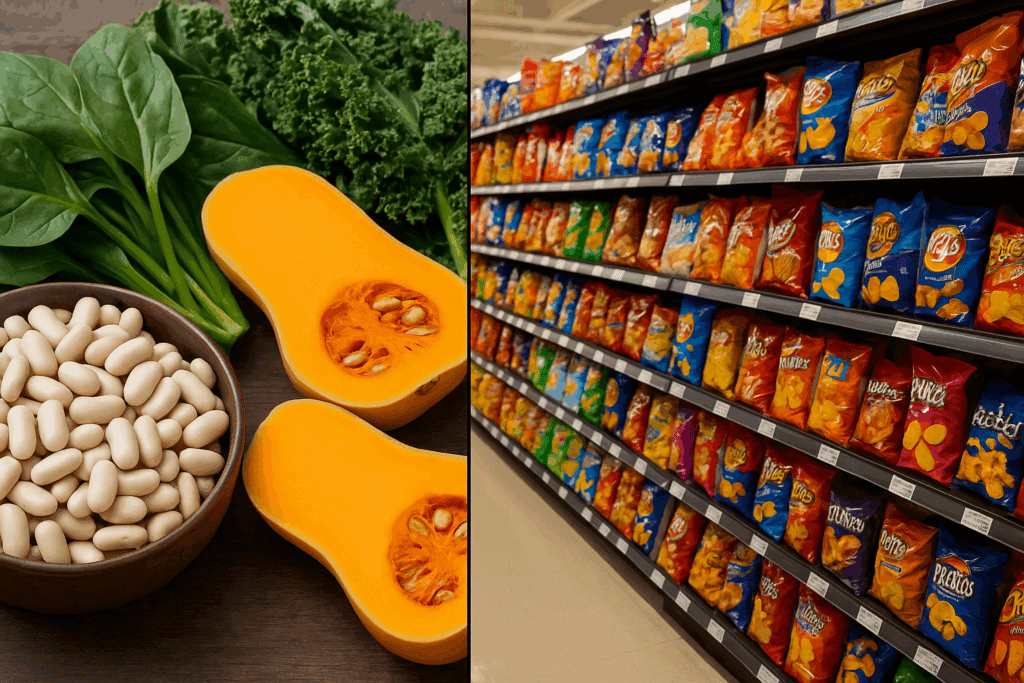
Challenges and Misconceptions About Potassium Intake
Despite the known benefits of potassium, many adults do not meet the recommended daily intake of 2,600 to 3,400 mg, depending on age and sex. A common misconception is that potassium is only available in a limited range of foods, such as bananas. While bananas are indeed a good source, they are far from the only one. Beans, leafy greens, squash, and even potatoes with skin are all excellent sources that can be easily integrated into meals.
Another barrier to adequate potassium intake is the food industry’s emphasis on convenience over nutrition. Ultra-processed foods often displace healthier options in modern diets, leaving consumers with fewer natural sources of potassium. Additionally, individuals with certain health conditions, especially chronic kidney disease, are often advised to limit potassium intake due to the risk of hyperkalemia. This creates a delicate balance between encouraging increased potassium intake for cardiovascular protection and ensuring safety for vulnerable populations.
It is also important to dispel the myth that potassium supplements can serve as a quick fix for high sodium intake. While supplements may be appropriate in some clinical scenarios, they do not offer the same benefits as potassium obtained through whole foods, which come with additional nutrients and fiber that support overall health. The body processes potassium more effectively from food sources, and the risk of imbalance is lower compared to supplement use.

Expert Perspectives on Sodium and Potassium Balance for Long-Term Health
Leading nutritionists, cardiologists, and public health researchers consistently emphasize the importance of balancing sodium and potassium in the diet as a core strategy for long-term heart health. According to the American Heart Association, reducing sodium while increasing potassium can cut the risk of stroke, heart attack, and other cardiovascular diseases. This advice is grounded in decades of research, including landmark studies such as the INTERSALT study, which demonstrated a direct correlation between sodium-potassium ratios and blood pressure outcomes in diverse populations.
Many experts advocate for a shift in public health messaging from simply “reduce sodium” to a more balanced directive: “lower sodium and raise potassium.” This dual approach has the potential to make dietary guidelines more actionable and accessible. It also aligns with broader recommendations for plant-based eating patterns that are rich in vegetables, fruits, legumes, and whole grains.
Furthermore, advancements in nutritional genomics are opening new avenues for personalized approaches to managing the sodium and potassium balance. By identifying genetic markers that influence electrolyte sensitivity, healthcare providers can tailor dietary interventions with greater precision. This emerging field reinforces the concept that the answer to the question “can potassium cancel out sodium?” may depend as much on the individual as on the nutrients themselves.
Reflections on the Role of Sodium and Potassium in Preventive Cardiology
As the conversation around preventive cardiology evolves, the role of micronutrients like sodium and potassium has become increasingly prominent. These electrolytes, though small in molecular weight, exert outsized effects on vascular function and cardiovascular risk. By maintaining an optimal sodium and potassium balance, individuals can leverage one of the most accessible tools in the fight against heart disease: diet.
There is growing consensus that the modern food environment has tilted this balance unfavorably toward excessive sodium. However, the good news is that dietary patterns can be reshaped. Emphasizing whole foods, minimizing processed snacks, and choosing meals that naturally contain a favorable sodium-to-potassium ratio are practical steps with profound implications. Such changes do not require expensive interventions or radical lifestyle overhauls; they are achievable through everyday decisions and mindful eating.
Public health efforts should continue to highlight the importance of this nutritional balance, particularly in communities disproportionately affected by hypertension and related diseases. Educational campaigns, food labeling reforms, and access to fresh produce are all essential components of a strategy that promotes better heart health through improved dietary quality.
Frequently Asked Questions (FAQ): Can Potassium Cancel Out Sodium? What Experts Say About Balancing Sodium and Potassium for Better Heart Health
1. If I consume too much salt in a meal, can potassium cancel out sodium immediately afterward?
While it’s tempting to think that eating a high-potassium food like a banana can instantly neutralize the effects of a salty meal, the reality is more complex. The notion that potassium can cancel out sodium in real-time oversimplifies how these electrolytes interact. Potassium helps the body excrete excess sodium through urine over time, but this is a gradual physiological process and depends on kidney function, hydration status, and overall dietary patterns. A single high-potassium snack won’t fully offset the blood pressure spike or vascular stress triggered by a very salty meal. That said, consistent adherence to a low sodium high potassium dietary pattern offers long-term cardiovascular benefits that extend far beyond any one meal.
2. What are some lesser-known signs that I may have an imbalance between sodium and potassium?
Symptoms of an imbalance between sodium and potassium can go unnoticed for years, but subtle warning signs may include muscle cramps, irregular heartbeat, chronic fatigue, and even mood disturbances. These effects occur because both sodium and potassium are crucial for nerve transmission and muscle contraction, including the function of the heart. A persistently high sodium and low potassium intake may also contribute to sleep disruption or increased sensitivity to stress due to heightened sympathetic nervous system activity. Unlike more obvious symptoms of nutrient deficiency, electrolyte imbalances often present as general malaise, making them harder to trace without bloodwork. That’s why monitoring your intake of sodium and potassium—and maintaining a low sodium high potassium balance—is crucial for preventive wellness.
3. Can athletes or people who sweat a lot rely on potassium to protect their heart from high sodium intake?
Athletes and individuals who lose electrolytes through heavy sweating may assume that replenishing potassium can fully counteract the effects of sodium, but this can be misleading. Although active individuals often require more sodium due to increased loss through sweat, this does not negate the need for potassium. In fact, the sodium and potassium balance becomes even more important in high-performance settings because it affects hydration, muscle recovery, and cardiovascular output. Athletes who habitually consume high-sodium sports drinks without sufficient potassium-rich foods may still face elevated blood pressure risks over time. Incorporating both electrolytes strategically—preferably through whole food sources—ensures better heart health and performance longevity.
4. Are there health conditions where a low sodium high potassium diet might be dangerous?
Yes, for certain individuals, especially those with chronic kidney disease, heart failure, or who are taking specific medications like ACE inhibitors or potassium-sparing diuretics, a high-potassium diet can be risky. In these cases, the kidneys may not be able to excrete potassium efficiently, leading to hyperkalemia—a condition characterized by dangerously high potassium levels that can cause arrhythmias or cardiac arrest. While general health advice encourages a shift toward low sodium high potassium eating, medical supervision is essential for people with these conditions. It’s a reminder that even the most heart-healthy nutrients require personalization based on your medical history and lab values. Always consult with a healthcare provider before making significant dietary changes involving sodium and potassium.
5. How does a low sodium high potassium diet affect mental health and cognitive function?
Emerging research suggests that the sodium and potassium ratio may also play a role in cognitive performance and mental health. High sodium intake has been linked to increased risk of cognitive decline and even mood disorders like depression, while potassium supports neuronal function and cerebral blood flow. A diet rich in potassium may help mitigate the inflammatory effects of high sodium levels, which could otherwise impair cognitive flexibility and memory over time. Moreover, improved vascular health from better sodium-potassium balance may enhance oxygen delivery to the brain, supporting executive function and mental clarity. While more clinical studies are needed, adopting a low sodium high potassium diet appears to offer not only heart benefits but potential neuroprotective effects as well.
6. Are there food prep techniques that help preserve potassium while reducing sodium?
Absolutely. Cooking methods and ingredient selection can significantly influence your sodium and potassium intake. For instance, boiling vegetables can leach out potassium, especially if the water is discarded, so steaming or roasting is preferable for potassium retention. Conversely, rinsing canned foods like beans or vegetables can reduce their sodium content by nearly 40%. Using potassium-rich flavor enhancers such as lemon juice, garlic, or fresh herbs can elevate taste without the need for added salt. Choosing minimally processed ingredients and cooking from scratch are the most effective strategies to maintain a favorable sodium and potassium profile in meals.
7. What does the latest research say about the sodium to potassium ratio being more important than individual intake levels?
Recent studies increasingly highlight the significance of the sodium to potassium ratio rather than focusing solely on absolute intake levels of either mineral. This means that even if someone stays within the recommended sodium guidelines, a low intake of potassium could still place them at risk for hypertension and related conditions. Researchers now propose that the ideal dietary pattern is one where potassium intake significantly exceeds sodium intake, preferably at a ratio of 2:1 or higher. This shift in focus helps explain why some populations with relatively high sodium intake still experience low rates of heart disease—they also consume high levels of potassium from natural food sources. The growing emphasis on the interplay between sodium and potassium reframes nutritional advice from isolated targets to overall dietary balance.
8. How can restaurants and meal delivery services better support a low sodium high potassium lifestyle?
Restaurants and meal delivery services have a growing responsibility to support health-conscious consumers seeking better sodium and potassium balance. One way is by clearly labeling meals with sodium and potassium content, allowing diners to make informed choices. Additionally, offering more dishes with fresh produce, legumes, and whole grains can naturally enhance potassium intake without relying on supplements. Training chefs to use natural flavor boosters instead of excess salt can maintain taste while reducing sodium levels. By highlighting low sodium high potassium options on menus, businesses can contribute to a larger public health effort aimed at combating hypertension and chronic disease.
9. Is it possible to use digital health tools to track and optimize sodium and potassium intake?
Yes, with advancements in digital health technology, it’s now easier than ever to monitor the sodium and potassium content of your diet. Mobile apps like Cronometer, MyFitnessPal, and other nutrition trackers often include comprehensive databases that list both sodium and potassium values for common foods. Some even allow for the customization of intake goals based on individual health needs or recommendations from a registered dietitian. Wearable devices and smart kitchen tools are also evolving to provide real-time feedback on food choices and nutrient density. These tools can empower individuals to maintain an optimal sodium and potassium balance and answer the question of “can potassium cancel out sodium” with actionable, data-driven strategies.
10. What are some innovative ways to promote public awareness about the sodium and potassium connection?
Public health campaigns have traditionally focused on reducing sodium, but there’s a growing need to equally highlight the benefits of potassium-rich foods. Schools, workplaces, and community centers can play a vital role by offering educational workshops, cooking demos, and meal planning resources that emphasize low sodium high potassium eating. Social media influencers and healthcare providers alike can amplify this message by sharing practical tips and success stories. Furthermore, policymakers can encourage food manufacturers to reformulate products with more favorable sodium and potassium ratios. Raising awareness of how sodium and potassium work together will ultimately help more people understand that while potassium alone may not fully cancel out sodium, it is an essential part of rebalancing a diet for long-term heart health.
Conclusion: Balancing Sodium and Potassium for Lifelong Heart Health
In the quest for better cardiovascular outcomes, the relationship between sodium and potassium stands out as a central, modifiable factor. While potassium may not fully cancel out the effects of excessive sodium intake, it plays a critical compensatory role that can protect against hypertension and its complications. The science clearly supports the benefits of a low sodium, high potassium diet, both for individuals at risk of cardiovascular disease and for the general population seeking to maintain heart health.
Understanding how sodium and potassium work together allows for more informed dietary choices rooted in evidence rather than hype. Rather than seeking quick fixes or silver bullets, the most effective strategies involve consistent, sustainable changes—swapping out processed foods, prioritizing potassium-rich produce, and adopting cooking habits that emphasize natural flavor over salt. This approach is not only medically sound but also empowering, placing the tools for heart disease prevention squarely in the hands of individuals.
As research continues to illuminate the intricacies of this electrolyte balance, one thing remains clear: dietary patterns that favor potassium over sodium are strongly associated with better heart health. Embracing this knowledge can lead to meaningful improvements in quality of life, reduced disease burden, and longer, healthier lives for people across the globe. In the end, the answer to whether potassium can cancel out sodium is both practical and hopeful—yes, when paired with mindful eating and lifestyle choices, it can help rebalance the scales toward wellness.
Further Reading:
The Imbalance of Sodium and Potassium Intake: Implications for Dietetic Practice


